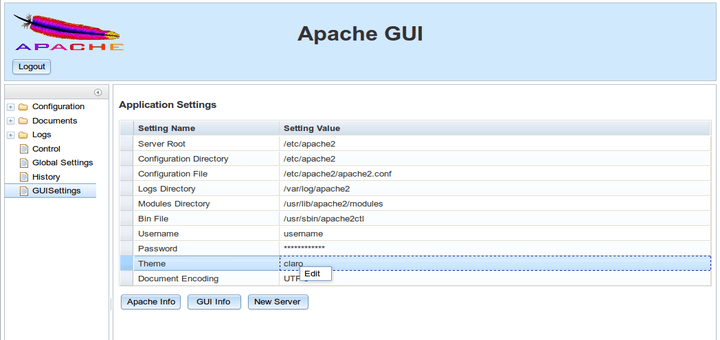Apache HTTP server

The Apache HTTP Server, an open-source web server developed by the Apache Software Foundation. The Apache server is used to host web content. It responds to requests for content from web browsers, such as Internet Explorer and Firefox.
Apache is an iconic open source web server, with a proud history stretching more than 20 years in the open source community. Licensed under a standard Apache Software Foundation Apache 2.0 License, the web server is both free to use, distribute, and modify, without being subject to royalties or other license fees. Apache is the most commonly used Web server on Linux systems. Web servers are used to serve Web pages requested by client computers. Clients typically request and view Web pages using Web browser applications such as Firefox, Opera, Chromium, or Internet Explorer. Apache http Server. Apache is a very well known open-source Web Server. It is not only popular but also very old Web Server. Like any other Web Servers, Apache also accepts requests from the clients, search for the requested queries and then send the response back to them. Also Read: How to install Anaconda on Linux && Install Redis on Linux.
Installing Apache
To configure your system as a web server, begin by installing the httpd software package.
The Apache HTTP daemon supports name-based hosting so that multiple domain names can share one IP address. Changing a host name effectively changes your website's domain name, since your visitors request the site by sending its host name, in the form of a URL, to your specified port in the request's HTTP headers. The Apache web server is easy to install. With one command, you can install it and all necessary dependencies: $ dnf install httpd All the configuration files for Apache are located in /etc/httpd/conf and /etc/httpd/conf.d.
Use the systemctl utility to enable the HTTP daemon to start at boot time and also to start the daemon immediately. Aerial for mac.
Nursery wall letter. This type of equipment is a high quality mailbox designed for wall mounting. It features a classic stylization and it is made of solid brass. It is a heavy-duty construction that has also got decorative character. Your mail will be kept safe from weather elements in this stylish sheer metal letter box.
Configuration files
Apache Web Server Download


The main configuration file for Apache is /etc/httpd/conf/httpd.conf. An auxiliary directory, /etc/httpd/conf.d, also exists to store configuration files that are included in the main configuration file. Configuration files that load modules are in the /etc/httpd/conf.modules.d directory.
New apachectl subcommands in CentOS / RHEL 7
A new apachectl sub-commands are available in CentOS / RHEL 7. The following example uses the configtest subcommand to check the configuration for possible errors.
Use the graceful subcommand to reload the configuration without affecting active requests.
Configuring Apache
The main configuration file for Apache is /etc/httpd/conf/httpd.conf. Apache runs as installed, but you can modify configuration directives in this file to customize Apache for your environment. Some of these directives are described in the post below.

Testing Apache HTTP server
You can confirm that Apache is working by pointing a browser on the local system to http://localhost as shown in the picture below. You can also point a browser to http:// followed by the IP Public address of the server or the ServerName directive that you specified in the configuration file. The test page shown below confirms the functioning Apache HTTP server.
To test the display of actual content, create an HTML file named index.html in the directory specified by the DocumentRoot directive (the default directory is /var/www/html). Apache automatically displays the index.html file in this directory, if it exists.
Apache Containers
Apache containers are special configuration directives that group other directives. The containers use XML-style tags, meaning that the beginning of a container is <name> and the end is </name>. An index of all the container directives is available at http://httpd.apache.org/docs/current/sections.html. Refer the post below to get the most commonly used apache containers.
Apache Virtual Hosts
Usb lan card for mac. Apache supports virtual hosts, meaning that a single Apache server can respond to requests directed to multiple IP addresses or host names. Each virtual host can provide content and be configured differently.
You can configure virtual hosts in two ways:
1. IP-based Virtual Hosts (host-by-IP)
2. Name-based Virtual Hosts (host-by-name)
Apache Windows Download
host-by-IP
With host-by-IP, each virtual host has its own IP address and port combination. The Apache web server responds to the IP address that the host resolves as. Host-by-IP is required for serving HTTPS requests due to restrictions in the Secure Sockets Layer (SSL) protocol.
host-by-name
With host-by-name, all virtual hosts share the common IP address. Apache responds to the request by mapping the host name in the request to ServerName and ServerAlias directives in the particular virtual host’s configuration file.
Use the <VirtualHost host-name> container to implement virtual hosts. After the first VirtualHost is defined, all of the content served by Apache must also be moved into virtual hosts.
The following example is a simple name-based virtual hosts configuration:




